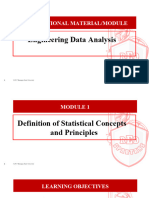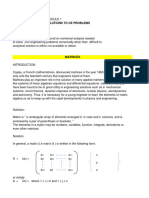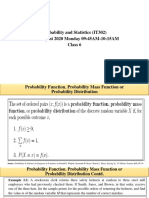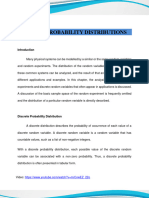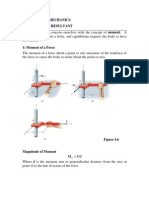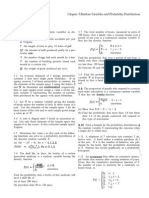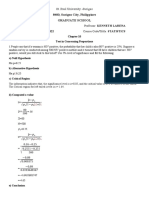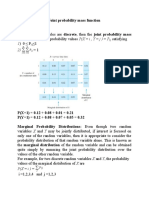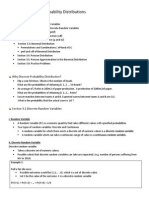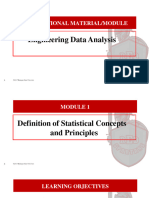0 ratings0% found this document useful (0 votes)
215 views30 pagesRandom Variable P
Uploaded by
novia rahmadhaniCopyright
© © All Rights Reserved
We take content rights seriously. If you suspect this is your content, claim it here.
Available Formats
Download as PDF or read online on Scribd
0 ratings0% found this document useful (0 votes)
215 views30 pagesRandom Variable P
Uploaded by
novia rahmadhaniCopyright
© © All Rights Reserved
We take content rights seriously. If you suspect this is your content, claim it here.
Available Formats
Download as PDF or read online on Scribd
You are on page 1/ 30
Chapter 3
Random Variables and Probability
Distributions
3.1
Concept of a Random Variable
Statistics is concerned with making inferences about populations and population
characteristies. Experiments are conducted with results that are subject to chance.
The testing of a number of electronic components is an example of a statistical
experi provess by which several chance
observations are generated. It is often important to allocate a numerical description
to the outcome. For example, the sample space giving a detailed description of each
possible outcome when three electronic components ate tested may be written
yent, a term that is used to describe an
$= {NNN,NND,NDN, DNN,NDD,DND, DDN, DDD},
where NV denotes nondefective and D denotes defective. One is naturally concerned
with the number of defectives that occur. Thus, each point in the sample space will
be assigned a numerical value of 0, 1, 2, or 3. These values are, of course, random
quantities determined by the outcome of the experiment. They may be viewed as
values assumed by the random variable X, the number of defective items when
three electronic components are tested,
‘Arandom variable is a function that associates a real number with each element
in the sample space.
We shall use a capital letter, say X, to denote a random variable and its correspond-
ing small letter, 1 in this ease, for one of its values. In the electronic component
testing illustration above, we notice that the random variable X assumes the value
2 for all elements in the subset
E
(DDN, DND, NDD}
of the s
is a subset of the sample space for the given experiment
ple space 8. That is, each possible value of X represents an event that
al
82 Chapter 3 Random Variables and Probability Distributions
‘Hxample $.1:] Two balls are drawn in succession without replacement from an urn containing 4
red balls and 3 black balls. The possible outcomes and the values y of the random,
variable Y, where ¥ is the number of red balls, are
“Sample Spacey
RR 2
RB 1
BR 1
BB 0
4
Pxample 9.2: A stockroom clerk returns three safety helmets at random to three steel mill em-
ployees who had previously checked them. If Smith, Jones, and Brown, in that
order, receive one of the three hats, list the sample points for the possible orders
of returning the helmets, and find the value m of the random variable M that
represents the number of correct matches.
Solution: If 8, J, and B stand for Smith’s, Jones's, and Brown’s helmets, respectively, then
the possible arrangements in which the helmets may be returned and the number
of correct matches are
Sample Space _m
SUE a
SBI 1
BIS 1
JSB 1
JBS 0
BSI o a
In each of the two preceding examples, the sample space contains a finite number
of elements, On the other hand, when a die is thrown until a 5 occurs, we obtain
a sample space with an unending sequence of elements,
VF. J,
S={F,NENNF,
VN
where F and N’ represent, respectively, the occurrence and nonoceurrence of a 5.
But even in this experiment, the number of elements can be equated to the number
of whole numbers so that there isa first clement, a second element, a third element,
and so on, and in this sense can be counted.
‘There are cases where the random variable is categorical in nature. Variables,
often called dummy variables, are used. A good illustration is the case in whieh
the random variable is binary in nature, as shown in the following example.
example 8.8:| Consider the simple condition in which components are arriving from the produc-
tion line and they are stipulated to be defective or not defective. Defi
variable X by
__ [1 ifthe component is defective,
© 10, if the component is not defective
3.1 Concept of a Random Variable 83
Clearly the assignment of 1 or 0 is arbitrary though quite convenient. This will
become clear in later chapters. The random variable for which 0 and 1 are chosen
to describe the two possible values is called a Bernoulli random variable. 1
Further illustrations of random variables ate revealed in the following examples.
Example 3.
Statistic sampling plans to cither accept or reject batches or lots of
material. Suppose one of these sampling plans involves sampling independently 10
items from a lot of 100 items in which 12 are defective.
Let X be the random variable defined as the number of items found defec-
tive in the sample of 10. In this ease, the random variable takes on the values
0,1,2,.-.,9,10. 4
| Suppose a sampling plan involves sampling items from process until a defective
is observed. ‘The evaluation of the process will depend on how many consecutive
items are observed. In that regard, let X be a random variable defined by the
number of items observed before a defective is found. With N’ a nondeleetive and
D a defective, sample spaces are S = (D} given X = 1, $= {ND} given X = 2,
$= {NND} given X = 3, and 30 on, 4
Example 3.
IInerest centers around the proportion of people who respond to a certain mail
order solicitation. Let X be that proportion. is @ random variable that takes
fon all values 2 for which 0 < 2 < 1 a
Example 3.
Example
Let X be the random variable defined by the waiting time, in hours, between
successive speeders spotted by a radar unit. ‘The random variable X takes on all
values x for which x > 0. 4
'iFa sample space contains a nite numiber of possibilities or an unending sequence
vith as many elements as there are whole numbers, itis called a discrete sample
space.
‘The outcomes of some statistical experiments may be neither finite nor countable.
Such is the case, for example, when one conducts an investigation measuring the
distances that a certain make of automobile will travel over a prescribed test course
on 5 liters of gasoline. Assuming distance to be a variable measured to any degree
of accuracy, then clearly we have an infinite number of possible distances in the
sample space that cannot be equated to the number of whole numbers. Or, if one
were to record the length of time for a chemical reaction to take place, once again
the possible time intervals making up our sample space would be infinite in number
and uncountable. We see now that all sample spaces need not be discrete,
Definition 3.3:
A random variable is called a diserete random variable if its set of possible
‘outcomes is countable, The random variables in Examples 3.1 to 3.5 are discrete
random variables, But a random variable whose set of possible values is an entire
interval of numbers is not discrete. When a random variable can take on values
st
Chapter 3 Random Variables and Probability Distributions
con a continuous scale, it is called a continuous random variable. Often the
possible values of a continuous random variable are precisely the same values that,
are contained in the continuous sample space. Obviously, the random variables
described in Examples 3.6 and 3.7 are continuous random variables.
In most practical problems, continuous random variables represent measured
data, such as all possible heights, weights, temperatures, distance, or life periods,
whereas discrete random variables represent count data, such as the number of
defectives in a sample of k items or the number of highway fatalities per year in
fa given state, Note that the random variables ¥ and M of Examples 3.1 and 3.2
both represent count data, Y the mumber of red balls and M the number of correct
hat matches,
3.2 Discrete Probability Distributions
A discrete random variable assumes each of its values with a certain probability.
In the case of tossing a coin three times, the variable X, representing the number
of heads, assumes the value 2 with probability 3/8, since 3 of the 8 equally likely
sample points result in two heads and one tail. Ifone assumes eqnal weights for the
simple events in Example 3.2, the probability that no employee gets back the right
helmet, that is, the probability that M assumes the value 0, is 1/3. The possible
values m of M and their probabilities are
m joi s
Pi =m)
Note that the values of m exhaust all possible cas
add to 1
Frequently, itis convenient to represent all the probabilities ofa random variable
X by a formula, Such a formula would necessarily be a function of the numerical
values # that we shall denote by f(z), 92), r(2), and so forth. ‘Therefore, we write
); that is, f(8) The set of ordered pairs (2, f()) is
called the probability function, probability mass function, or probability
distribution of the discrete random variable X.
nd hence the probabilities
‘The set of ordered pairs (x, [(z)) is probability function, probability mass
function, or probability distribution of the discrete random variable X if, for
each possible outcome 2,
1. f(z) > 0,
2 DF)
3. PIX = 2) = f(a)
4,
| shipment of 20 similar laptop computers to a retail outlet contains 3 that are
dofeetive. If a school makes a random purchase of 2 of these computers, find the
probability distribution for the number of defectives.
: Lot X be'a random variable whose values 2 are the possible numbers of defective
computers purchased by the school. Then « ean only take the numbers 0, 1, and
3.2 Discrete Probability Distributions 85
2. Now
f() = P(X =
9) = 3
10) = POC = 2) = atl =
“Thus, the probability distribution of X is
* | 01
FETE
| car agency sells 50% of its inventory of x certain foreign ear equipped with side
airbags, find a formula for the probability distribution of the number of cars with
Side airbags among, the next 4 cars sold by the agency
Solution: Since the probability of selling an automobile with side airbags is 0.5, the 24 = 16
points in the sample space are equally likely to occur. ‘Therefore, the denominator
for all probabilities, and also for our fanction, is 16. ‘To obtain the mnnber of
sways of selling 3 cars with side aithags, we nced to consider the mnmnber of ways
of partitioning 4 outcomes into two ells, with 3 cara with side airbags assigned
Example 3.
to one cell and the model without side airbags assigned to the other. This can be
done in ({)= 4 ways. In general, the event of selling x models with side airbags
and 4—2 models without side airbags can occur in (8) ways, where x can be 0, 1,
2, 3, or 4. Thus, the probability distribution f(x) = P(X = 2) is
so)= 5 (2), fora ,
‘There are many problems where we may wish to compute the probability that
the observed value of a random variable X will be less than or equal to some real
umber x, Writing F(x) = P(X < 2) for every real number 1, we define F(z) to
be the cumulative distribution function of the random variable X.
112,34.
Definition 3.5: [The cumulative distribution function F(z) of a discrete random variable X
with probability distribution f(x) is
FQ) = P(X <2)= TW, for -v0<2< 0.
For the random variable M, the number of correct matches in Example 3.2, we
have
FQ) = P(M <2) = f(0) + $0) =
‘The cumulative distribution function of M is
0, form <0,
, for0Sm 3.
86
Example 3.10:]
Solutio
Chapter 3 Random Variables and Probability Distributions
‘One should pay particular notice to the fact that the cumulative distribution fune=
tion is a monotone nondecreasing function defined not only for the values assumed
by the given random variable but for all real numbers.
Find the cumulative distribution fanetion of the random variable X in Example
3.9. Using F(x), verify that {(2) = 3/8.
rect calculations of the probability distribution of Example 3.9 give J(0)= 1/16,
F(1) = 1/4, f(2)= 8/8, f(3)= 1/4, and f(4)= 1/16. Therefore,
FO = 50) = 5
Fa) =s0) +10) = 5,
FQ) = $00) +10) +40) =,
FQ) = $0) +10) +42) +10) = 2
FU) = f(0) + 10) +52) + 00) 44)
Hence,
0, fore <0,
Ye forO<24.
Now
£(2) = P()- Fa)
6 4
It is often helpful to look at a probability distribution in graphic form. One
right plot the points (2, f(#)) of Example 3.9 to obtain Figure 3.1. By joining
the points to the 2 axis either with a dashed or with a solid line, we obtain a
probability mass function plot. Figure 8.1 makes it easy to sce what values of X
are most likely to oceur, and it also indicates a perfectly symmetric situation im
this case
Instead of plotting the points (x, f(x), we more frequently construct rectangles
as in Figure 8.2. Here the rectangles are constructed so that their bases of equal
width are centered at each value 2 and their heights are equal to the corresponding
probabilities given by f(z). The bases are constructed so as to leave no space
between the rectangles. Figure 3.2 is called a probability histogram.
Since each base in Figure 3.2 has unit width, P(X = =) is equal to the area
of the rectangle centered at «. Even if the bases were not of unit width, we eould
adjust the heights of the rectangles to give areas that would still equal the proba-
bilities of X assuming any of its values x. ‘This concept of using areas to represent
3.3 Continuous Probability Distributions 87
fo) 19
are| . ane)
ste i sie
ane oo ane
an pod od ang
ane| ne ane
sna gat
1 z s + * 0 1 2 3 4 *
Figure 3.1: Probability mass funetion plot. Figure 3.2: Probability histogram.
probabilities is necessary for our consideration of the probability disteibution of a
3.3,
‘continuous random variable,
‘The graph of the cumulative distribution function of Example 3.9, which ap-
pears as a step function in Figute 3.3, is obtained by plotting the points (2, F())
Certain probability distributions are applicable to more than one physical situ-
ation. The probability distribution of Example 3.9, for example, also applies to the
random variable Y, where ¥ is the number of heads when a coin is tossed 4 times,
or to the random variable W,, where W is the number of red cards that occur when
4 cards are drawn at random from a deck in succession with each card replaced and
‘the deck shufiied before the next drawing, Special discrete distributions that can
be applied to many different experimental situations will be considered in Chapter
5.
Figure 3.8: Discrete cumulative distribution funetion.
Continuous Probability Distributions
A continuous random variable has a probability of 0 of assuming ezacfly any of its
values. Consequently, its probability distribution cannot be given in tabular form.
88
Chapter 3 Random Variables and Probability Distributions
AL first this may seem startling, but it becomes more plausible when we consider a
particular example. Let us discuss a random variable whose values are the heights
of all people over 21 years of age. Between any two values, say 163.5 and 164.5
centimeters, or even 163.99 and 164.01 centimeters, there are an infinite mumber
of heights, one of which is 164 centimeters. The probability of selecting a person
at random who is exactly 164 centimeters tall and not one of the infinitely large
set of heights so close to 164 centimeters that you cannot humanly measure the
difference is remote, and thus we assign a probability of 0 to the event. ‘This is not
the case, however, if we talk about the probability of selecting a person who is at
least 163 centimeters but not more than 165 centimeters tall. Now we are dealing
with an interval rather than a point value of our random variable.
We shall concern ourselves with computing probabilities for various intervals of
continuous random variables such as P(a < X <6), P(W > c), and so forth. Note
that when X is continuous,
Plac X 0. To verify condition 2 in Definition 3.6, we have
90 Chapter 3 Random Variables and Probability Distributions
(b) Using formula 3 in Definition 3.6, we obtain
pocxB.
To determine the probability that the winning bid is less than the preliminary bid
‘estimate 8, we have
PUY 0,
10 {FF
Find the probability that a bottle of this medicine will,
have a shell life of
(8) at least 200 days;
(b) anywhere from 80 to 120 days.
3.7 ‘The total number of hours, measured in units of
100 hours, that a family runs a Yacuum cleaner over a
period of one year is a continuous random variable X
‘that has the density fimetion
Sle) = fe 5
0,
Find the probability that over a period of one year, a
family runs their vacuum cleaner
(2) less than 120 hours;
(b) between 50 and 100 hours.
O 3);
(9) Pas 2)
3.18 The probability distribution of X, the number
of Imperfections per 10 meters of a synthetic fabric in
fontinuous rolls of uniform width, is given by’
e[o 1 2 3 4
ay Oa oat 0005 —0T
Construct the cumulative distribution function of X.
3.14 ‘The waiting time, in hours, between successive
speeders spotted by a radar unit is a continuous ran
dom variable with cumulative distribution function
2<0,
220.
rey= {P
Find the probability of waiting loss than 12 minutes
between successive speeders
{a) using the cumulative distribution funetion of X;
(b) using the probability density function of X.
8.15. Find the cumulative distribution function ofthe
random variable X representing the number of defec-
tives in Exercise 8.11. Then using F(), find
(a) PIX =);
() PO 0);
() PLE W <3).
3.24. Find the probability distribution for the number
of jazz CDs when 4 CDs are selected at random from
8 ollection consisting of 5 jazz CDs, 2 classical CDs,
and 3 rock CDs, Express your results by means of &
formula,
8.25 From a box containing 4 dimes and 2 nickels,
S coins are selected at random without replacement.
Find the probability distribution for the tatal T of the
3 coins. Express the probability distribution graphi-
zally a8 a probability histogram,
8.26 From a box containing 4 black balls and 2 green
balls, balls are drawn in succession, each ball being
replaced in the box before the next draw is made. Find
the probability distribution for the number of green
balls,
3.27 The time to failure in hours of an important
piece of electronic equipment used in a mannfactured
VD player has the density fanetion
(= exp(—r/2000), 2 > 0,
°
se) peo
(a) Find F(a),
(b) Determine the probability that the component (and
thus the DVD player) lasts more than 1000 hours
before the component needs to be replaced
(c) Determine the probability that the component fails
‘before 2000 hors
3.28 A coreal manufacturer is aware that the weight
ff the product in the box varies slightly from box
to box. In fact, considerable historical data have al-
owed the determination of the density function that
describes the probability structure for the weight (in
‘ounces). Letting X be the random variable weight, in
‘ounces, the density function can be described as
_ [Bt <2< 2525,
ro {) Soice
(a) Verity that this is a valid density function
(b) Determine the probability that the weight is
smaller than 24 ounces.
() The company desires that the weight exceeding 26
ounces be an extremely rare occurrence. What is
the probability that this rare occurrence does ac-
tually occur?
8.29 An important factor in solid missle fuel ts the
particle size distribution. Significant problems occur if
‘the particle sizes are too large. From production data
in the past, i has been determined that the particle
sige (in micrometers) distribution is characterized by
se ={E"
(a) Verity that this is a valid density function
(b) Evaluate F(x)
(©) What is the probability that a random particle
from the manufactured fuel exceeds 4 micrometers?
eol
elsewhere
8.30 Measurements of scientific systems are always
subject to variation, some more than others. “There
fare many structures for measurement error, and statis-
ticians spend a great deal of time modeling these errors.
Suppose the measurement error X ofa certain physical
quantity is decided by the density function
AQ-27), -1<2<1,
10) {0 ee
(@) Determine k that
tion
(b) Find the probability that a random erwor in mea
surement is Tess than 1/2
(©) For this particular measurement, i i undesirable
ithe magnitude of the or (ie) |2}) exceeds 0.8
What isthe probability that this occurs?
ers f(z) a valid density func
m4 Chapter
3.81 Based on extensive testing, itis determined by
the manufacturer of a washing machine that the time
Y (in years) before a major repair is required is char-
acterized by the probability density function
fe"
(a) Critics would certainly consider the product a bar-
gain if tis unlikely to require a major repair before
the sixth year. Comment on this by determining
PUY > 8)
(b) What is the probability that a major repair occurs
in the first year?
¥20,
elsewhere
sv)
3.82. ‘The proportion of the budget for a certain type
of industrial company that is allotted to environmental
and pollution contro! is coming under scrutiny. A data
collection project determines that the distribution of
‘hese proportions is given by
_ fol-ws, asus,
10 eo ee
(2) Verity that the above is valid density function.
(b) What isthe probability that a company chosen at
random expends les than 10% ofits budget on ene
vironmental and pollution controls?
(6) What is the probability that a company selected
at random spends more than 50% of ss budget on
environmental and pollution controls?
8.83 Suppose a certain type of small data processing.
firm is so specialized that some have difficulty making
f profit in their fist year of operation. ‘The probabil:
ity density function that. characterizes the proportion
Y¥ that make a profit is given by
ky —¥)’, OS y <1.
0, elsewhere
fw
(a) What js the value of F that renders the above
valid density function?
(b) Pind the probability that at most 50% of the firms
make a profit in the first year.
() Find the probability that at least 80% of the firms
make a proft in the first year
8 Random Variables and Probability Distributions
3.344 Magnetron tubes are produced on an automated
assembly line. A sampling plan is used periodically to
assess quality of the lengths of the tubes. ‘This mnea-
surement is subject to uncertainty, Tt is thought that
the probability that a random tube meets length speo-
ification is 0.99. A sampling plan is used in which the
lengths of 5 random tubes are measured
(a) Show that the probability function of Y, the mum.
ber out of 5 that meet length specification, is given
by the following discrete probability function
1
Fo) = Fe FOsarcoony*,
for y= 0,1,2,3,4,5.
(b) Suppose random selections are made off the line
‘and 3 are outside specifications. Use f{y) above ei-
ther to support or to refute the conjecture that the
probability is 0.09 that a single tube moets specif-
cations.
8.85 Suppose it is known from lange amounts of bis-
torical data that X, the number of cars that arrive at
a specific intersection during a 20-second time period,
's characterized by the following diserete probability
function:
8 ere a0.12
Se
{a) Find the probability that in a specific 20-second
time period, more than 8 cars arrive at the
intersection,
(b) Find the probability that only 2 ears arrive
8.86 On a laboratory assignment, ifthe equipment is
‘working, the density fonction of the observed outcome,
xe
ga) = FO“
O 0.5, what is the probability that
2X wil be loss than 0.75
3.4 Joint Probability Distributions
Our study of random variables and th
ing sections is restricted to one-dimensional sample spaces,
ir probability distributions in the preced-
in that we recorded
outcomes of an experiment. as values assumed by a single random variable. There
will be situations, however, where we may find it desirable to record the simulta-
34 Joint Probability Distributions
Definition 3.8:
neous outcomes of several random variables. For example, we might measure the
amount of precipitate P and volume V of gas released from a controlled chemical
experiment, giving tise to a two-dimensional sample space consisting of the out-
comes (p,}, oF we might be interested in the hardness H and tensile strength T
‘of cold-drawn copper, resulting in the outcomes (h,). In a study to determine the
likelihood of suecess in college based on high school data, we might use a three-
dimensional sample space and record for each individual his or her aptitude test
score, high schoo! class rank, and grade-point average at the end of freshman year
in college.
If.X and ¥ are two discrete random variables, the probability distribution for
their simultaneous occurrence can be represented by a function with values f(2,y)
for any pair of values (x,y) within the range of the random variables X and Y. It
is customary to refer to this function as the joint probability distribution of
X and ¥.
Hence, in the diserete ease,
Slay) = P(X =2,¥ =);
that is, the values f(x,y) give the probability that outcomes x and y occur at
the same time. For example, if an 18 wheeler is to have its tires serviced and X
represents the number of miles these tires have been driven and Y represents the
number of tires that need to be replaced, then f(30000, 5) is the probability that
the tires are used over 80,000 miles and the truck needs 5 new tires.
The Fanetion f(x,y) ia joint probability distribution or probability mass
function of the discrete random variables X and Y if
1. F(e,y) 2 0 for all (x,y),
2. EY sey)
3. P(X =2,Y =y)
Por
S(x,y),
y region A in the xy plane, P(X,Y) € 4) = EY Slev)
[-Pwo ballpoint pens are selected at random from a box that contains $ blue pens,
2 red pens, and 3 green pens, If X is the number of blue pens selected and ¥ is
the mumber of red pens selected, find
{a) the joint probability function f(x,y),
b) PIUX,Y) € A], where A is the region {(x,u)la+y <1}
Solution: The possible pairs of values (x,y) are (0,0), (0,1), (1,0), (1,1), (0,2), and (2,0)
(a) Now, /(0,1), for example, represents the probability that a red and a green
pons are selected. The total number of equally likely ways of selecting any 2
pens from the 8 is ($) = 28, The number of ways of selecting 1 red from 2
red pens and 1 green from 3 green pens is (2)(}) = 6. Hence, (0,1) = 6/28
= 3/14, Similar calculations yield the probabilities for the other cases, which
are presented in Table 8.1. Note that the probabilities sum to 1. In Chapter
96 Chapter 3 Random Variables and Probability Distributions
obability distribution of Table 3.1 can
5, it will become clear that the joint p
bbe represented by the formula
ots)
flo) = OO),
fort =0,1,%y=0,1,%and0 0,
34 Joint Probability Distributions 99
where A and B are now the events defined by X = and ¥
vy, respectively, then
Pk =2¥=9) _ flaw)
P(X =2) ote)”
PY =y|X =2)= provided g(z) > 0,
where X and ¥ are diserete random variables,
It is not difficult to show that the function f(x,y) /a(2), whieh is strictly a fme-
tion of y with a fixed, satisfies all the conditions of a probability distribution. ‘This
is also trae when f(2,y) and g(x) are the joint density and marginal distribution,
respectively, of continuous random variables. As a result, itis extremely important
that we make use of the special type of distribution of the form /(z,y)/g(z) in
order to be able to effectively compute conditional probabilities. This type of dis
tribution is called a conditional probability distribution; the formal definition
follows.
Definition 3.1:
Tet X and ¥ be two random variables, discrete or continuous. The conditional
[distribution of the random variable Y given that X = 2 is
sale) = 222, provided ge) > 0
Sinilany, the conditional distribution of X given that ¥ = y is
Slely) = few) provided h(y) > 0.
Ay)
If we wish to find the probability that the discrete random variable X falls between
and b when it is known that the discrete variable Y = y, we evaluate
Pa5| x=
‘Example $.20:| Given the joint density function
19), cred ocy Lifleve
34 Joint Probability Distributions 103
for the discrete case, and
ahead = [oo [sera nytn) ea ds dg
for the continuous case, We can now obtain joint marginal distributions such
tas g(ei,t2), where
ole: nf EF ler ta,. tn) (discrete case),
PPP Sleisaas stn) ds de---den (continuous case)
We could consider numerous conditional distributions. For example, the joint con-
ditional distribution of Xz, Xz, and Xs, given that Xa = 24,X5 ~ 25,..45Xq =
2, is written
desctaty | tate... ang) = LEB)
Flos | Bets oy) = FE)
where g(2ta,2,-.-,2n) is the joint marginal distribution of the random variables
Xe eyo Xn
A generalization of Definition 3.12 leads to the following definition for the rmu-
tual statistical independence of the variables Ni, Xa,..-.Xn
Definition 3.13: [Let Xy,Xa-Xn ben random variables, discrete or continuous, with
joint probability “distribution f(e1,22,...,2q) and marginal distribution
Sila), falta), ---; Snltn)s respectively. The random variables X1,Xo,...,Xq are
said to be mutually statistically independent if and only if
L(y 25-05 m) = filer falaa) + Salm)
for all (@1,22,---yy) within their range.
{uppose that the shelf life, im years, of a certain perishable food product packaged
im cardboard containers is a random varlable whose probability density function is
given by
e820
t= {0 ee
Let X1, Xz, and Xs represent the shelf lives for three of these containers selected
independently and find P(X1 < 2,1 < Xz <3, Xs > 2).
Solution: Since the containers were selected independently, we can assume that the random
variables X1, Xa, and Xs are statistically independent, having the joint probability
density
Sler.22,2s) = fer)flea)f a)
for 2 > 0, 29 >0,25>0,and f(es,22,25
POG << Xe <8.Xs> a= ff’ [ee 9 ae dee des
Bet ee
O elsewhere. Hence
104
Chapter 3 Random Variables and Probability Distributions
What Are Important Characteristics of Probability Distributions
and Where Do They Come From?
Exercises
‘This is an important point in the text to provide the reader with a transition into
the next three chapters, We have given illustrations in both examples and exercises
of practical scientific and engineering situations in which probability distributions
and their properties are used to solve important problems. These probability dis-
tributions, either discrete or continuous, were introduced through phrases like “it,
is known that” or “suppose that” oF even in some cases “historical evidence sug-
gests that.” These are situations in which the nature of the distribution and even
4 good estimate of the probability structure can be determined through historical
data, data from long-term studies, or even large amounts of planned data. ‘The
reader should remember the discussion of the use of histograms in Chapter 1 and
from that recall how frequency distributions are estimated from the histograms
However, not all probability functions and probability density functions are derived
from large amounts of historical data, There are a substantial number of situa~
tions in which the nature of the scientific scenario suggests a distribution type.
Indeed, many of these are reftected in exercises in both Chapter 2 and this chap-
ter, When independent repeated observations are binary in nature (e.g, defective
or not, survive or not, allergic or not) with value 0 or 1, the distribution covering
this situation is called the binomial distribution and the probability function
is known and will be demonstrated in its generality in Chapter 5. Exercise 3.34
in Section 3.3 and Review Exercise 3.80 are examples, and there are others that
the reader should recognize. ‘The scenario of a continuous distribution in time to
failure, as in Review Exercise 3.69 or Exercise 3.27 on page 93, often suggests dis-
tribution type called the exponential distribution. ‘These types of illustrations
are merely two of many so-called standard distributions that are used extensively
in real-world problems because the scientific scenario that gives rise to each of them
is recognizable and occurs often in practice. Chapters 5 and 6 cover many of these
types along with some underlying theory concerning their use.
‘A second part of this transition to material in future chapters deals with the
notion of population parameters or distributional parameters. Recall in
Chapter 1 we discussed the need to use data to provide information about these
parameters, We went to some length in discussing the notions of a mean and
variance and provided a vision for the concepts in the context of a population
Indeed, the population mean and variance are easily found from the probability
function for the discrete case or probability density function for the continuous
case, These parameters and their importance in the solution of many types of,
real-world problems will provide much of the material in Chapters 8 through 17.
3.87 Determine the values of ¢ s0 that the follow 3.88 If the joint probability distribution of X and Y
ing functions represent joint probability distributions is given by
of the random variables X’and Y:
(0) Sew
&) fe)
exy, for
cle yj fore = 20,2; y= —2.5
1,2,3; y= 1,235
Brereises
(0) PIX S2,Y =);
() POLS 2, <1):
© PR >Y);
@) PIX+Y = 4)
3.89 From a sack of fruit containing 3 oranges, 2 ap-
ples, and 3 bananas, a random sample of 4 pieces of
Fruit is selected, IF X is the number of oranges and Y
is the number of apples in the sample, find
(a) the joint probability distribution of X and ¥;
(b) PIK,Y) € A], where A is the rogion that is given
by (eu) |2+y <2}
8.40 A fast-food restaurant operates both a drive-
through facility and a walk-in facility. On a randomly
selected day, let X and ¥, respectively, be the propor-
tions of the time that the drive-through and wallein
facilities are in use, and suppose that the joint density
Function of these random variables is
Be +2), O<2<1, 05yS1
so = {3
cleowhere
(@) Find the marginal density of X.
(b) Find the marginal density of ¥.
{c) Find the probability that the drive-through facility
is busy less than one-half of the time
3.41 A candy company distributes boxes of choco-
lates with a mixture of exeams, toffees, and cordials.
Suppose that the weight of each box is I kilogram, but
the individual woights of the creams, toffees, and cor-
dials vary from bex to box. For a randomly selected
box, let X and ¥ represent the weights of the creams
and the toffee, respectively, and suppose thatthe joint
Aensity function of these variables is
Dzy,
fen {F
(a) Find the probability that in given box the eordials
account for more than 1/2 of the weight.
(b) Find the marginal density for the weight of the
{c) Find the probability that the weight of the toffees
Ja box is less than 1/8 of a kilogram if tis known,
that creams constitute 3/4 of the weight
O<2<1,0 0, y>0,
wlsewhere,
find P(O< X <1|¥ =2).
3.43 Lot X denote the reaction time, in seconds, to
‘ecertain stimulus and Y denote the temperature CF)
‘at which a certain reaction starts to take place. Sup-
pose that two random vatiables X and ¥ have the joint
density
tiny, O<2 <1, O 1/2),
Oczeysl,
elsewhere
3.46 Referring to Exercise 3.38, find
(@) the marginal distribution of X;
(b) the marginal distribution of.
3.47 ‘The amount of kerosene, in thousands of liters,
jn a tank at the beginning of any day is a random
‘amount ¥ from which a random amount X is sold dur
ing that day. Suppose that the tank is not resupplied
during the day so that 2 < y, and assume that the
Joint density function of these variables is
nea= {5 deen
(a) Determine if X and Y are independent,
106 Chapter
(0) Pind POA c X < 1/21
Va),
S48 Referring to Exercise 8.89, find
(2) £(912) for al values of y
(b) P(Y =0| X =2)
3.49 Let X denote the number of times a certain m-
‘merical control machine will malfunction: 1, 2, oF 3
times on any given day. Let Y denote the number of
‘times a technician is called on an emergency call. ‘The!
Joint probability distribution is given as
fey [3
[as as
3 | 005 a10 035
y 5 | 000 020 a0
(e) Brntuate the marginal dstribtion of X
(b) Evaluate the marginal distribution of Y.
(©) Fina PY
3.50 Suppose that X and ¥ have the following, joint
probability distribution:
Sev)
fey |
vy 3 [020 030
5 |ouo 0.15
(a) Find the marginal distribution of X.
(b) Find the marginal distribution of ¥.
3.51 Three cards are drawn without replacement
from the 12 face cards (jacks, queens, and kings) of
tn ordinary deck of 52 playing cards. Let X be the
rhamber of kings selected and Y the number of jacks.
Find
(a) the joint probability distribution of X and Y;
(b) PICK,Y) © A), where A is the region given by
{eu) [249 22}
3.52 A coin is tossed twice. Let Z denote the number
‘of heads on the frst toss and W the total nuznber of |
heads on the 2 tosses. If the coin is unbalanced and a
hhead has a 40% chance of occurring, find
(2) the joint probability distribution of W and Z;
(b) the marginal distribution of W:
(c) the marginal distribution of 2;
(a) the probability that at least 1 head occurs.
8 Random Variables and Probability Distributions
3.53 Given the joint density function
(= Ord 2eyed,
Le = Yo, elsewhere,
find PQ) ¥ <3| X=3).
8.54 Determine whether the two random variables of
Exercise 3.19 are dependent or independent.
8.55 Determine whether the two random variables of
Exercise 4.50 are dependent or independent.
3.56 ‘The joint density function of the random vari-
ables X and ¥ is
x,
,
(@) Show that X and ¥ are not independent
(b) Find P(X > 038| ¥ = 05).
O<2 4,1< 7 <2),
3.58 Determine whether the two random variables of
Exercise 3.43 are dependent or independent.
8.59 Determine whether the two random variables of
Exercise 3.44 are dependent or independent.
8.60 The joint probability density function of the ran-
dom variables X,Y, and Z is
set o cay O,
fen o, elsewhere.
() Give the marginal density functions for both ran-
dom variables.
{(b) What is the probability that the lives of both com
ponents will exceed 2 hours?
3.64. A service facility operates with two service lines.
On a randomly selected day, let X be the proportion of,
time that ¢he first line is in use whereas Y is the pro-
portion of time that the second line isin use. Suppose
that the joint probability density function for (X,¥) is
{ger O 05,¥ > 0.5)
O 2)
8.69. The life span in hours of an electrical compo-
‘ont isa random variable with eumalative dstsiation
fimetion
Loew, 20,
Fe Ste
108 Chapter
(a) Determine its probability density function,
(b) Determine the probability that the life span of such
‘8 component will exceed 70 hours
8.70. Pairs of pants are being produced by a particu
lar outlet facility. ‘The pants are checked by a group of
10 workers ‘The workers inspeet pais of pants taken
randomly from the production line. Each inspector is
assigned a number from 1 through 10. A buyer selects
‘pair of pants for purchase, Let the random variable
X°be the inspector number.
(8) Give a reasonable probability mass function for X.
(b) Plot the cumulative distribution function for X.
3.71 ‘The shelf life of a product is a random variable
that is related to consumer acceptance. Tt turns out
‘that the shelf life Yin days of a certain type of baker
product has @ density fimetion
fe"
What fraction of the loaves of this product stocked to-
day would you expect to be sellable 3 days from now?
0 05?
(2) Give the conditional distribution fx, (2ilz2)
8.76 Consider the situation of Review Exercise 8.75.
But suppose the joint distribution of the two propor
tons is given by
62a,
seen) = {f
{a) Give the marginal distribution fx, (#1) of the pro-
portion Xy and verify that itis a valid density
function,
(®) Whar js the probability that proportion X2 is less
than 0.5, given that Xy is 0.7?
Ocmcn
You might also like
- Math 3Eng-T Engineering Data Analysis Problem Set #4 Due Date: Sep 24, 2020 (12 NN) Justin M. Marquez BET-Automotive General InstructionsNo ratings yetMath 3Eng-T Engineering Data Analysis Problem Set #4 Due Date: Sep 24, 2020 (12 NN) Justin M. Marquez BET-Automotive General Instructions5 pages
- Ens185 Engineering Data Analysis SyllabusNo ratings yetEns185 Engineering Data Analysis Syllabus3 pages
- MATH 403 Module 2. Concepts of ProbabilityNo ratings yetMATH 403 Module 2. Concepts of Probability34 pages
- 7 - Sampling Distributions & Point Estimation of ParametersNo ratings yet7 - Sampling Distributions & Point Estimation of Parameters45 pages
- Engineering Data Analysis - Samples With SolutionsNo ratings yetEngineering Data Analysis - Samples With Solutions3 pages
- Chapter 5 Joint Probability Distributions 2No ratings yetChapter 5 Joint Probability Distributions 249 pages
- Probability and Statistics (IT302) 17 August 2020 Monday 09:45AM-10:15AM Class 6No ratings yetProbability and Statistics (IT302) 17 August 2020 Monday 09:45AM-10:15AM Class 623 pages
- Discrete Probability Distributions GuideNo ratings yetDiscrete Probability Distributions Guide18 pages
- Problem Set 3 in Engineering Data AnalysisNo ratings yetProblem Set 3 in Engineering Data Analysis1 page
- Differential Equations Problems and SolutionsNo ratings yetDifferential Equations Problems and Solutions19 pages
- Engineering Mechanics 4 Force System ResultantNo ratings yetEngineering Mechanics 4 Force System Resultant24 pages
- Engineering Statistics and Probability Chapter 3No ratings yetEngineering Statistics and Probability Chapter 325 pages
- Ln2 Sync Elimination of Arbitrary Constants and Families of Curves g079 A g097 ANo ratings yetLn2 Sync Elimination of Arbitrary Constants and Families of Curves g079 A g097 A23 pages
- Statistics: Normal & Exponential DistributionNo ratings yetStatistics: Normal & Exponential Distribution21 pages
- (LN) Engineering Economy - EnginerdmathNo ratings yet(LN) Engineering Economy - Enginerdmath39 pages
- PCEA 006 - Module 1 - Kinematics (Rectilinear Motion) - Sample Problems For ReviewNo ratings yetPCEA 006 - Module 1 - Kinematics (Rectilinear Motion) - Sample Problems For Review6 pages
- Livro Hibbeler - 7 Ed Resistencia Materiais (Soluções) - 4 PDF100% (1)Livro Hibbeler - 7 Ed Resistencia Materiais (Soluções) - 4 PDF50 pages
- Central Philippine University College of Engineering Course Syllabus Emath 1202 Engineering Data AnalysisNo ratings yetCentral Philippine University College of Engineering Course Syllabus Emath 1202 Engineering Data Analysis8 pages
- Chapter 3 Discrete Probability Distributions - Final 3No ratings yetChapter 3 Discrete Probability Distributions - Final 327 pages




